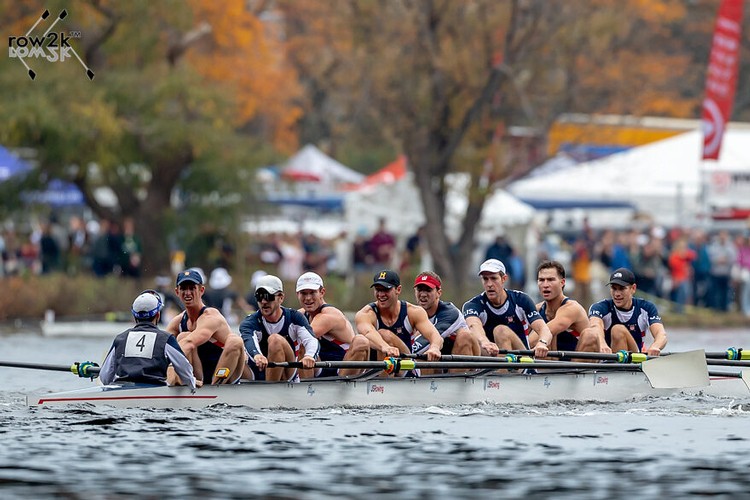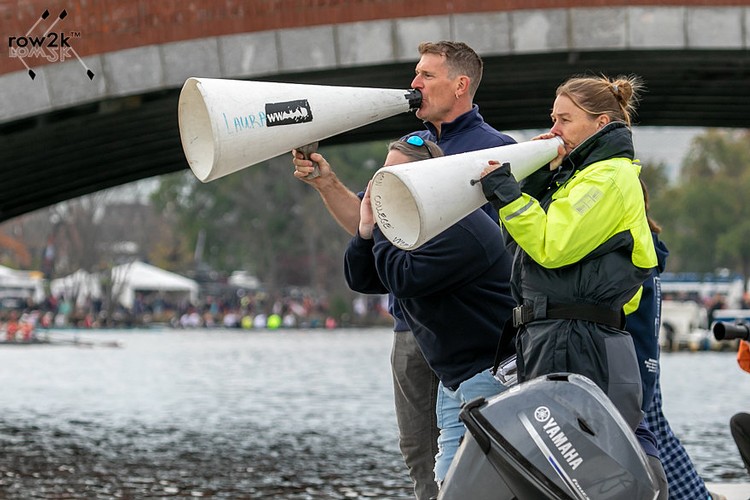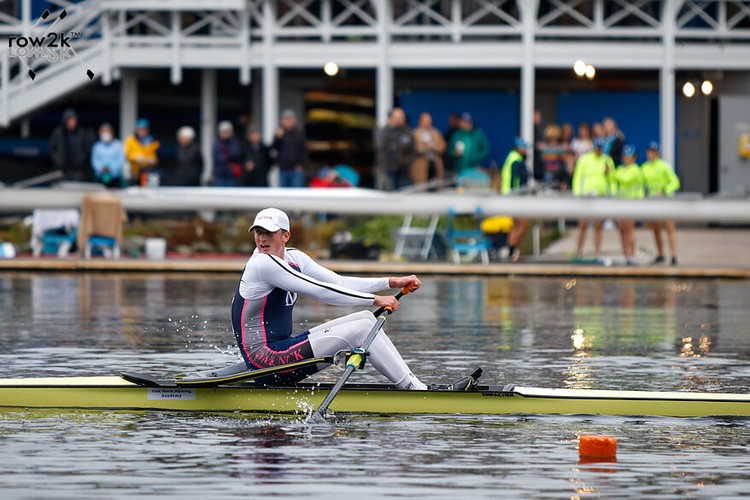
Welcome to a special HOCR version of our usual Tuesday In the Driver's Seat column.
The Charles is, after all, a day that is all about coxing well--in the boats that have them at least--the kind of day where you have to tip your hat to great steering: like the guy who buzzed the Winsor dock so tightly that the row2k photographer sitting on the edge had to lifts his legs so the blade could pass underneath...whew!
We last caught up with coxswains in 2011, when we asked them about the second trickiest turn, where you can lose time, the river's sweet spots, motivating starboards on the Eliot turn and, of course, crashes.
This year, we spoke with four coxswains, all multiple winners of the Charles--John Chatzky, Amanda Milad Cox, Leigh Heyman, and Stew Stokes--about first minute of the race, the Weeks Turn, surviving clashes, and how the heck to do a good warmup in a three-mile long single file line.
How many times have you won the Head of the Charles and who are you coxing this weekend?
Leigh Heyman: I have won the head of the Charles eight times and counting. This year I am coxing a women's masters eight called Masters Coaching.

John Chatzky:I think I've actually won it five or six times and I've probably got 30 medals, and I coxed the 1980 Rowing Club in the Grand Master Eights, which has been rowing in the regatta for over 40 years.
Amanda Milad Cox:Four times. I cox the CBC Senior Master Four with C. B. Sands-Bohrer, Linda Muri, Olwen Huxley and Jennifer Sacheck-Ward. We didn't quite make it to a fifth gold, but we found out afterwards that we still have our course record, by .9 seconds. So a small consolation prize, and then the other consolation prize was that it's really cool to see masters women get faster. This is the Title Nine generation that's going in their fifties, so we're all excited to see a generation of women who are have been rowing, training, and racing for their whole adult lives in the event.
Stokes: Actually only four times.
row2k: 'Only four' puts you tied for third place in this article, Stew.
Stokes: I know [laughing]. The crew I have been coxing for years is the Etats Unis boat, in the Grand Master Eights race.
How do you approach the first minute of the race?
Heyman: The first minute of the race is really about setting the rhythm and the tempo. There's so much sensory input as you make your way up to the start and into the chute, that it's really about just shaking loose all those bugs. There's not many moves that you can make in the first minute that will like yield big changes in your standing that early in the race. There's nothing special you can do on the first turn, there's no moves you can make, so it's really about taking the dopamine hit of the start and turning that into a nice, clean, tight rhythm: focusing on the mood you want to set for the rest of the race.
Stokes: It's got to be not too many strokes above base rate: two to four strokes above base rate for anywhere from 30 seconds to a minute-wherever it sort of feels good and then let the crew find its base rhythm on its own.

Cox: I try to keep it really calm and focused. We have been in a lucky position to start with bow number one the past few years, so it's been really about establishing our rhythm and establishing our own race. Even if we were to start in another position, that's what I'm thinking about that in turn right before you get to Magazine Beach: find that rhythm, so that when we get into the Powerhouse Stretch, a couple of minutes into the race, we can take advantage of the straightaway.
Chatzky: The first minute of the race, we just want to get off hard and fast, but steady. We don't go particularly high, as a start. We just start at race cadence and try to get a smooth rhythm before the first turn of the race course.
Why is the Weeks Bridge turn so hard?
Stokes: Because of the tendency to want to be further over to port than is appropriate early on, and then to have the discipline to stay out where you need to be to try and make the right turn is very difficult.

Chatzky: Well, Weeks is not at all hard, if you do it correctly. Correctly is: you don't get too tight to the abutment too early. You start from the middle of the abutment, or from one-third of the way to the left of the abutment, and then you start to turn before you get to the bridge so you have your bow pointed correctly before you come out of the bridge.
Cox: Well, I don't nail the Week's turn everytime, so I'm not going to say it's not hard. It is hard if you're going through it with a lot of other crews and I think the hardest thing about it is being patient to take the turn at the last minute. It's really tempting, but you have to be patient: it looks like you're not going to make the turn and then you wait to make it at the right moment, or else you're in a wonky position and you've overshot it.
My first ever Head of the Charles, I was up all night for a week: the Weeks Turn, what am I going to do about the Weeks Turn? I was rowing on the Charles every day, since I was at Simmons College, but that was still what was keeping me up at night. Then, the day before my race, I was down at FALS and I met [US Olympic coxswain] Mary Whipple and she said, "Well, watch out for the Elliot bridge. I hit it once." So I went from I thought I was supposed to be worried about the Weeks Turn to worrying about Eliot--but that was probably one of my best courses ever, because I was so neurotic.

Heyman: I think the Weeks Turn is hard for three reasons. Number one, is the bridge itself: the angle of the bridge can be an optical illusion and it's especially challenging just for the dynamics of the way boats turn, especially a long eight. The actual turn is a good full boat length before you get to the bridge: if you hug the bridge too tightly, you end up like in a really bad position for the right hand turn at Andersen and you end up swinging really wide and having to row extra meters to get back up to where you can make the Anderson turn.

Number two: they typically set the buoy line in a way that tracks the shore of the river itself, which adds another layer of deception: the buoy line can trick you into turning at the wrong time, because of the way they turn.
Then the third thing is that it's so common, when you are tussling with other boats, that Weeks is where boats tend to bunch up. If you've been trying to pass or are getting passed in the Powerhouse straight, those battles tend to hit their apex right at that turn. There's a lot of mental calculations you have to do about your boat speed and the relative speeds of other crews, because you can get into a lot of trouble otherwise. That's why there's so many crashes there, because of the deceptive nature of the turn, plus trying to pass or get passed, can lead to a lot of bad decisions.
How do you survive close encounters with other crews?
Cox: It's really staying focused within the crew. It's easy to get flustered, but you have to recognize how much that flusters your crew. You have to recognize that your demeanor impacts your crew so much, so it's about trying to assess what's happening before it happens, by being constantly being aware of your surroundings. The primary job really is to assess several steps ahead to avoid anything, and then trying to communicate in a calm manner, in order to get through that situation and then have good strokes afterwards.

Chatzky: I have a single rule of close encounters, especially with other boats: DO NOT YIELD! Yell at the other coxswain, make everybody on river think it's their fault, rather than yours. Say it loudly and with authority, and you don't have to swear but just just pretend that you are in the right and everybody has to yield out of your way. That's a serious answer, and yes, it works.
Heyman: Well, I would have given a very different answer to that in my younger years [laughs], but now the answer really is about keeping your head and making best decisions--and sometimes those best decisions are counterintuitive. There's a lot of circumstances where it's both safer and faster to stop and take a pause--to even stop rowing for a millisecond or to call off the pressure--to let things open up, rather than try to force a bad situation. But it takes a clear head and a mature, level-headed coxswain or sculler to do that: it's really hard to do when the blood's pumping.
There's also just the advice that I've always gotten through my career: if you have the choice between steering and talking, you have to stop talking and steer.
Stokes: Trying to stay as calm as you want your rowers to stay. Then talking them through what the situation is and how you're approaching it, to help them respond in the right way. That makes it a little bit easier for the coxswain to understand what they need to do. That's what I've found: you have to talk to your rowers.

How do you manage your crew's warmup on the row up the course, before you get to the Basin?
Chatzky: Okay. I'm going to reveal a secret, for what you do, especially in a big eight when you're competing with other large boats: after you launch, you let everybody get as far in front of you as you can: waiting, waiting, waiting until a boat comes up to your stern. Before that boat comes up to your stern, and with maximum distance off of your bow, you do your warmup. If you end up closing and getting in another bottleneck, you do the same thing. Stop your eight, give yourself two or three hundred meters of clear space in front of you, and then go again before the closing crew behind you catches you.
Cox: I've actually only launched from FALS once, so I'm probably not the best person to ask, but a lot of Charles is making sure you're warmed up on land and have appropriate layers with you. It's so stop and go, and it can be touchy. I've been launching from the BU for the past five years, so we have the opposite problem. We're trying to get back all the way to the start after a race, and then it's about making sure that one extra layer because you don't want to be having raced and sitting cold on the way back.

Stokes: We launch from Newell, but If I had to go from FALS, I would just let them do their look around and be as relaxed as we can, getting through Cambridge and past the Cambridge Boat Club and down towards Newell. I would try to get them pretty locked in by sixes through the Weeks Bridge and then start the full crew-your all eight and your 10s or hard strokes-down towards the starting line. Then, you just need to put the finishing touches on it around the warm up area.
You're not going to get much done in the single file line, so let them be a little bit relaxed. Let them enjoy the scene a little bit and then keep talking them through what's going on when you're in the warm up area. What you see happening further out, when the other events are starting. The new cox boxes, because of the GPS, have the time built right into it so you can let them know exactly how many minutes until they're starting, things like that. In my crew, with all the old timers, they all know each other so there's lots of fun bantering back and forth, which is nice but probably very different from the energy at the start of some of the other races.
Heyman: Most crews I'm with now, we try to get as warm as we can on land before launching and I tell folks: we're not going to get a lot of speed work or pressure work done on the way. It's honestly being in the moment and half the fun of this regatta is the orchestrated chaos on the way to the start. You just learn to make that fun. You lean in and you get excited about it, and you actually use that as your warmup: the dopamine hit of all the excitement and chaos of all the boats around you and all the people. It's just so exciting, and that's going to naturally get your heart rate up. I'm getting my heart rate up just talking about it right now.
So I think using that helps, and then there's that moment right before you're queued up. There's nothing left to do. You've checked the rig. Everyone's ready to go, and here's just this kind of quiet that kind of comes over the over the crews. You get that moment where you're just ready and that's your moment to shake all that loose: let all the chaos go and put it all right back into the boat.

Comments | Log in to comment |
There are no Comments yet
| |
If you enjoy and rely on row2k, we need your help to be able to keep doing all this. Though row2k sometimes looks like a big, outside-funded operation, it mainly runs on enthusiasm and grit. Help us keep it coming, thank you! Learn more.
- Bont Rowing
- Calm Waters Rowing
- Concept 2
- Craftsbury Sculling
- The Crew Classic
- CrewLAB
- Croker
- Dad Vail Regatta
- Durham Boat Co.
- Empacher
- Faster Masters
- Filippi
- Fluidesign
- h2row.net
- HUDSON
- myrow
- Nielsen-Kellerman
- Oak Ridge RA
- Peinert Boat Works
- Pocock Racing Shells
- Race1 USA
- Rockland Rowing Masters Regatta
- RowKraft
- Rubini Jewelers
- Vespoli USA
- WinTech Racing
- Bont Rowing
- Calm Waters Rowing
- Concept 2
- Craftsbury Sculling
- The Crew Classic
- CrewLAB
- Croker
- Dad Vail Regatta
- Durham Boat Co.
- Empacher
- Faster Masters
- Filippi
- Fluidesign
- h2row.net
- HUDSON
- myrow
- Nielsen-Kellerman
- Oak Ridge RA
- Peinert Boat Works
- Pocock Racing Shells
- Race1 USA
- Rockland Rowing Masters Regatta
- RowKraft
- Rubini Jewelers
- Vespoli USA
- WinTech Racing































